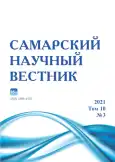Phenetics of the rock pigeon (Columba livia) plumage coloration in Orenburg
- Authors: Chirkova E.N.1, Zavaleeva S.M.1, Sadykova N.N.2, Mingazov R.R.1
-
Affiliations:
- Orenburg State University
- Buzuluk Institute of Humanities and Technology (branch) of Orenburg State University
- Issue: Vol 10, No 3 (2021)
- Pages: 129-132
- Section: General Biology
- URL: https://journals.rcsi.science/2309-4370/article/view/90478
- DOI: https://doi.org/10.17816/snv2021103119
- ID: 90478
Cite item
Full Text
Abstract
Birds differ from larger representatives, for example: mammals from the point of studying the class of birds. The following things are considered: data on hair dryers of coloring, patterns of feather cover, structure and coloring of the beak, flapping of the legs. Representatives of the class of birds, in particular synanthropic blue pigeons, have signs: features of trophic behavior and polymorphism. The paper describes distribution and main morphs of blue pigeons on the territory of Orenburg. The blue pigeon (Columba livia) is one of the most widespread ancient representatives, which is prone to migrations and has an extensive habitat around the world, and in urban conditions is one of the most frequently observed objects. Pigeons on the territory of Orenburg are represented by different morphs: white, black, black-stamped, brown and blue. On the territory of the Central District, during two periods, 1650 individuals of birds (1040 in spring, 610 in autumn) of different color morphs were identified, with a large predominance of black-stamped and brown. During the spring period the maximum number of birds and morphemes was high and during the autumn period the population decreased in number, as well as the ratio of the number of color morphemes. The observations were carried out in the Central District of Orenburg on three streets: March 8th, Tereshkova, Pobedy Avenue. 35 morphemes were identified in the Central District: 21 in spring and 14 in autumn. Spring morphemes in groupings, as well as their increase, were explained by combinative variability (that is due to increased reproduction in the spring period) and manifestation of recessive traits in the phenotypes of plumage coloring. Autumn morphemes were few in number; as a result, the loss is explained by a weak stability of certain color morphemes to environmental factors.
Keywords
Full Text
##article.viewOnOriginalSite##About the authors
Elena Nikolaevna Chirkova
Orenburg State University
Author for correspondence.
Email: nnnmem@mail.ru
candidate of biological sciences, associate professor of Biology and Soil Science Department
Russian FederationSvetlana Mikhailovna Zavaleeva
Orenburg State University
Email: bio@mail.osu.ru
doctor of biological sciences, professor of Biology and Soil Science Department
Russian FederationNatalya Nikolaevna Sadykova
Buzuluk Institute of Humanities and Technology (branch) of Orenburg State University
Email: nataljaaladina@rambler.ru
candidate of biological sciences, associate professor of Bioecology and Technosphere Safety Department
Russian FederationRavil Rifovich Mingazov
Orenburg State University
Email: mingazov28@yandex.ru
student of Chemistry and Biology Faculty
Russian FederationReferences
- Котов А.А. Отряд голубеобразные // Птицы России и сопредельных регионов: рябкообразные, голубеобразные, кукушкообразные, совообразные / отв. ред. В.Д. Ильичев, В.Е. Флинт. М.: Наука, 1993. С. 47–182.
- Доржиев Ц.З. Экология симпатрических популяций голубей. М.: Наука, 1991. 151 с.
- Ковалев В.А. Приспособительные изменения в поведении некоторых птиц в урбанизированном ландшафте // Беркут. 1996. Т. 5, вып. 1. С. 55.
- Харченко Н.Н., Лихацкий Ю.П., Харченко Н.Н. Биология зверей и птиц: учебник для студ. высш. учеб. заведений. М.: Академия, 2003. 382 с.
- Ильичев В.Д. Общая орнитология: учебник для биол. спец. вузов. М.: Высшая школа, 1982. 464 с.
- Панасийская Н.Г., Кассал Б.Ю. Фенетика окраски оперения синантропного сизого голубя (Columba livia f. Synanthropic) в г. Омске // Juvenis scientia. 2016. № 2. С. 49–51.
- Константинов В.М., Вахрушев А.А. Опыт массового учёта врановых птиц, зимующих в Москве // Фауна и экология наземных позвоночных животных на территориях с разной степенью антропогенного воздействия: межвуз. сб. науч. тр. / отв. ред. А.В. Михеев. М.: МГПИ, 1985. С. 17–21.
- Чиркова Е.Н., Чекмарев Д.С. Видовой состав врановых на территории города Оренбурга // Актуальные проблемы современной науки: теория и практика: мат-лы междунар. науч.-практ. конф. (г. Нефтекамск, Башкортостан). Нефтекамск: НИЦ «Мир науки», 2020. С. 68–73.
- Абросимова М.Г., Кассал Б.Ю. Рабочая тетрадь «Биологическое разнообразие (синантропные голуби)». Расчётно-аналитические задания: учебно-методическое пособие. Омск: ОмГПУ, 2005. 52 с.
- Абросимова М.Г., Кассал Б.Ю. Популяция синантропного голубя (Columba livia L.) как модель изучения морфологического разнообразия // Естественные науки и экология. Ежегодник: Межвуз. сб. науч. тр. Вып. 10. Омск: ОмГПУ, 2006. С. 115–120.
- Лакин Г.Ф. Биометрия: учеб. пособие для биол. спец. вузов, 4-е изд., перераб. и доп. М.: Высшая школа, 1990. 352 с.
- Обухова Н.Ю. Изменчивость окраски оперения в популяциях сизых голубей и механизмы ее поддержания: автореф. дис. … канд. биол. наук. М., 1987. 24 с.
- Ксенц А.С. Структура полиморфных синантропных популяций сизого голубя и вопросы его эстетико-хозяйственного значения: автореф. дис. … канд. биол. наук. Томск, 1982. 24 с.
- Рябицев В.К. Птицы Урала, Приуралья и Западной Сибири: справочник-определитель. 3-е изд., испр. и доп. Екатеринбург: Изд-во Уральского ун-та, 2008. 633 с.
- Ваничева Л.К., Мошкин М.П., Ксенц А.С., Родимцев А.С. Экологические особенности синантропных популяций сизых голубей (Columba livia Gm.) в промышленных центрах Западной Сибири и их использование в целях мониторинга // Сибирский экологический журнал. 1996. № 6. С. 585–596.
- Ксенц А.С., Москвитин С.С., Ксенц Г.Х. Различия в стратегии и тактике кормодобывания в синантропных популяциях сизого голубя (Columba livia Gm.) // Экология. 1985. № 6. С. 64–65.
- Обухова Н.Ю., Креславский А.Г. Изменчивость окраски в городских популяциях сизых голубей (Columba livia). Возможные механизмы поддержания полиморфизма // Зоологический журнал. 1985. Т. 64, вып. 11. С. 1685–1694.
- Северцов А.С. Внутривидовое разнообразие как причина эволюционной стабильности // Журнал общей биологии. 1990. Т. 51, вып. 5. С. 579–589.
- Яблоков А.В., Ларина Н.И. Введение в фенетику популяций. Новый подход к изучению природных популяций: учеб. пособие для студ. вузов. М.: Высш. шк., 1985. 159 с.
Supplementary files









